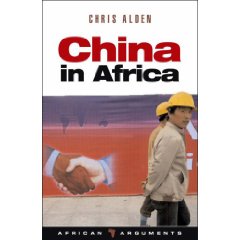|
Reviewed by Elizabeth Freund Larus, Ph.D., Associate Professor of Political Science, University of Mary Washington China is in the midst of a remarkable economic expansion, but much of their continued economic development is premised on the availability of energy resources and raw materials. Since the 1990s, China has aggressively tapped African countries for its resources to meet these needs. Chinese state and private firms are active in Africa exploiting hardwoods, pumping oil, mining minerals, rebuilding infrastructure, and investing in new hospitals and schools. At the same time, Chinese firms imported thousands of Chinese workers, ignoring the African unemployed. Chinese textile firms exploited workers with low wages and low labor standards, forcing domestic firms out of business. Chris Alden, a British academic who specializes in Asia-African relations, examines each of these issues in his detailed analysis of the method and intention of China’s relations with Africa. The book raises the question of whether China’s relations to Africa will be that of a development partner, economic competitor, or new exploiter. China is Africa’s third largest trading partner after the US and France. As Alden relates, Chinese trade and investment in Africa is driven largely by China’s international business corporations that retain strong ties to the central government. More than eight hundred Chinese state-owned firms are active in the African economy. Highly competitive and subsidized by the state, Chinese Multinational Corporations (MNCs) including CNOOC (the China National Offshore Oil Company), Sinopec, and Huawei Technologies are capturing key resources and market share across Africa. The story of Chinese MNCs has been told elsewhere, but Alden adds that Chinese small and medium enterprises (SMEs) are likewise expanding their presence in Africa. He argues that Chinese small-scale retailers threaten to undermine traditional retailers as Chinese SMEs are able to offer up low-cost consumer products that drive out traditional suppliers. Alden argues correctly that many Africans are unsettled by China’s presence on the continent. The establishment of Chinese businesses in Africa has fueled Chinese immigration to the continent. Chinese firms import workers for cheap labor, and Chinese provincial authorities encourage emigration as a means of acquiring foreign remittances. In some cases, the influx of Chinese laborers has exacerbated existing unemployment. African laborers employed in Chinese firms complain of low wages, low labor standards, and discrimination, while environmentalists are alarmed by the exploitation of Africa’s forests and minerals by Chinese companies. But it doesn’t end here. Chinese-financed dams have displaced indigenous populations; their criminal organizations engage in poaching of endangered wildlife products and; Chinese firms continue to present a challenge to Western companies for resources and market share. China’s expanding role in Africa is an important issue in international relations. Alden argues that Chinese aid props up undemocratic African regimes. China’s support for dictators and weak democracies is changing Africa’s relations with the West. As an alternative to the “Washington Consensus” imposition of conditionalities, China offers African leaders a “Beijing Consensus,” wherein China offers loans and forgives debt without any political conditions. Africa commands the largest percentage of China’s development assistance (44 percent). Much of this aid is gift in kind, in the form of soccer stadiums and government buildings, which are built by Chinese engineering firms with Chinese-sourced materials. The China Export-Import (Exim) Bank and the China Development Bank are key sources of funding for African projects. In fact, the Chinese Exim Bank has a portfolio thirty times greater than its nearest Western rival in Africa. China is the second largest arms dealer in Africa, and the Chinese supply arms to regimes barred from obtaining weapons from Western sources. Its arms have fueled civil war in Sudan and Ethiopia, and have kept Zimbabwean dictator Robert Mugabe in power. Alden claims that arms trade is among the reasons the West finds China’s engagement in Africa to be largely unsettling. Just as Chinese firms challenge the once-dominant position of Western firms on the continent, China’s arms sales to Africa may turn back any progress the continent has made toward democracy. Alden finds that responses to China in Africa have matured from condemnation to competition, and even to cooperation, as in the case of persuading China to support a UN force in Darfur. Alden’s book is small in size, but large in information. It provides the reader with a clear and comprehensive look at China’s involvement in Africa. Any serious student or scholar interested in China’s foreign policy and international relations, Asia-Africa relations, and African development studies, would find Alden’s book an essential resource. |


 China in Africa
China in Africa